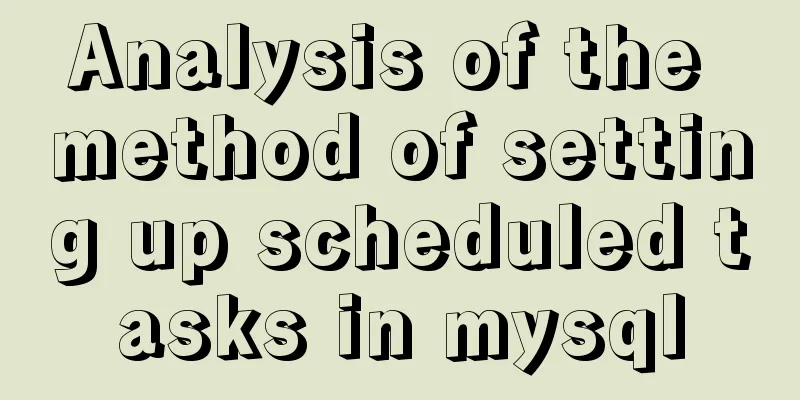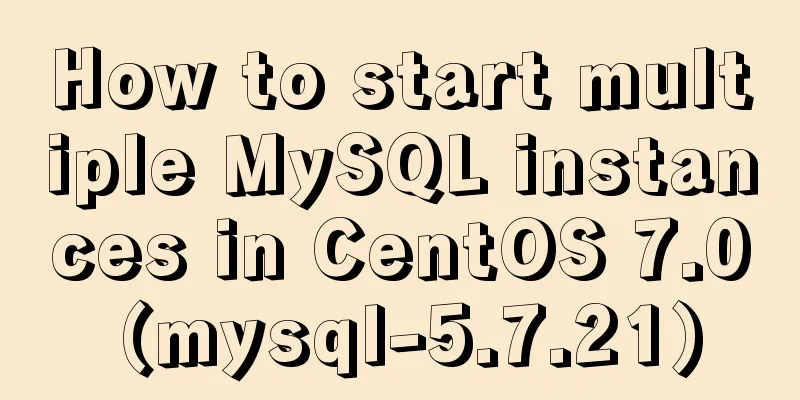Analysis of the method of setting up scheduled tasks in mysql

|
This article uses an example to describe how to set up scheduled tasks in MySQL. Share with you for your reference, the details are as follows: Today I encountered a task that needs to be executed regularly every day. Such a function is provided in the MySQL database, so I just organized it and shared it. 1. First check whether the scheduled task is turned on Check whether the event is enabled: SHOW VARIABLES LIKE '%event_sche%'; To open the event plan: SET GLOBAL event_scheduler = 1; To close the event schedule: SET GLOBAL event_scheduler = 0; Close event task: ALTER EVENT eventName ON COMPLETION PRESERVE DISABLE; To start the event task: ALTER EVENT eventName ON COMPLETION PRESERVE ENABLE; View event tasks: SHOW EVENTS; 2. Create a stored procedure
DELIMITER //
DROP PROCEDURE IF EXISTS p_test //
CREATE PROCEDURE p_test()
BEGIN
INSERT INTO test(name, create_time) values('testName', now());
END//
3. Set up a scheduled task to call this stored procedure (executed every ten seconds from 1:00 on August 8, 2015) DROP EVENT IF EXISTS e_test// CREATE EVENT e_test ON SCHEDULE EVERY 10 second STARTS TIMESTAMP '2015-08-08 01:00:00' ON COMPLETION PRESERVE DO BEGIN CALL p_test(); END// Note: In the event event: ON SCHEDULE scheduled task, there are two ways to set the scheduled task: 1. AT timestamp, used to complete a single scheduled task. 2. EVERY time (unit) quantity time unit [STARTS timestamp] [ENDS timestamp], used to complete repeated scheduled tasks. In both scheduled tasks, the timestamp can be any TIMESTAMP and DATETIME data type, and the timestamp needs to be greater than the current time. In a recurring scheduled task, the time (unit) quantity can be any non-null integer, and the time unit is a keyword: YEAR, MONTH, DAY, HOUR, MINUTE or SECOND. Tip: Other time units are also legal, such as: QUARTER, WEEK, YEAR_MONTH, DAY_HOUR, DAY_MINUTE, DAY_SECOND, HOUR_MINUTE, HOUR_SECOND, MINUTE_SECOND . It is not recommended to use these non-standard time units. [ON COMPLETION [NOT] PRESERVE] The ON COMPLETION parameter means "when this event will not occur again", that is, when a single scheduled task is completed or when a repetitive scheduled task reaches the ENDS stage. The function of PRESERVE is to prevent the event from being dropped after execution. It is recommended to use this parameter to view the specific information of EVENT. Readers who are interested in more MySQL-related content can check out the following topics on this site: "MySQL query skills", "MySQL transaction operation skills", "MySQL stored procedure skills", "MySQL database lock related skills summary" and "MySQL common function summary" I hope this article will be helpful to everyone's MySQL database design. You may also be interested in:
|
<<: How to add default time to a field in MySQL
>>: Vue implements time countdown function
Recommend
How to set static IP in CentOS7 on VirtualBox6 and what to note
Install CentOS 7 after installing VirtualBox. I w...
How to hide the border/separation line between cells in a table
Only show the top border <table frame=above>...
A brief discussion on how Tomcat breaks the parent delegation mechanism
Table of contents JVM Class Loader Tomcat class l...
js realizes the dynamic loading of data by waterfall flow bottoming out
This article shares with you the specific code of...
Method of Vue component document generation tool library
Table of contents Parsing .vue files Extract docu...
Detailed explanation of the principle and function of Vue list rendering key
Table of contents The principle and function of l...
CnBlogs custom blog style sharing
After spending half the night on it, I finally ma...
DockerToolBox file mounting implementation code
When using docker, you may find that the file can...
How to configure https for nginx in docker
Websites without https support will gradually be ...
Detailed tutorial on using Docker to build Gitlab based on CentOS8 system
Table of contents 1. Install Docker 2. Install Gi...
Solution to the problem that the text is on the lower left and cannot be resized when the textarea is laid out
Two small problems, but they bothered me for a lon...
JavaScript source code for Elimination
JavaScript to achieve the source code download ad...
mysql implements importing only a specified table from the sql file of exported data
Scenario Yesterday the system automatically backe...
Detailed explanation of several methods of deduplication in Javascript array
Table of contents Array deduplication 1 Double-la...
Docker completely deletes private library images
First, let’s take a look at the general practices...









